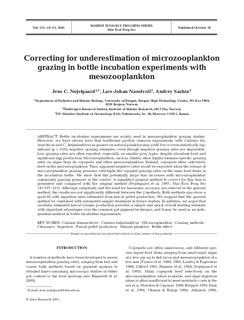Correcting for underestimation of microzooplankton grazing in bottle incubation experiments with mesozooplankton
Journal article, Peer reviewed
Permanent lenke
http://hdl.handle.net/11250/108346Utgivelsesdato
2001-10-18Metadata
Vis full innførselSamlinger
- Articles [3001]
Originalversjon
http://dx.doi.org/10.3354/meps221059Sammendrag
Bottle incubation experiments are widely used in mesozooplankton grazing studies.
However, we have shown here that traditional particle removal experiments with Calanus finmarchicus
and C. helgolandicus as grazers on natural plankton may yield low or even statistically significant
(p < 0.05) negative grazing estimates, even though negative grazing rates are impossible.
Low grazing rates are often reported, especially on smaller prey types, despite abundant food and
significant egg production. Microzooplankton, such as ciliates, show higher biomass-specific grazing
rates on algae than do copepods and other mesozooplankton. Instead, copepods often selectively
feed on the microzooplankton. Thus, apparent negative rates would be expected when the release of
microzooplankton grazing pressure outweighs the copepod grazing rates on the same food items in
the incubation bottle. We show that this potentially large bias increases with microzooplankton
community grazing pressure in the control. A simplified general method to correct for this bias is
presented and compared with the original method (Nejstgaard et al. 1997, Mar Ecol Prog Ser
147:197–217). Although complexity and the need for taxonomic accuracy are reduced in the general
method, the results are not significantly different between the 2 methods. Both methods also show a
good fit with ingestion rates estimated from faecal pellet production. We suggest that the general
method be combined with automated sample treatment in future studies. In addition, we argue that
carefully estimated faecal volume production provides a simple and quick overall feeding estimate
with important advantages over the common gut pigment technique, and it may be used as an independent
method in bottle incubation experiments.
